The OBDII Diagnostics window displays information obtained from the vehicle OBDII interface.
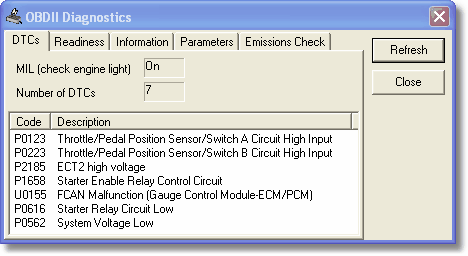
DTCs
DTCs (diagnostic trouble codes) or error codes are set by the ECU to indicate a problem with a system or component. DTCs are expressed as a four digit code, usually starting with a 'P' (for power train) related problems.

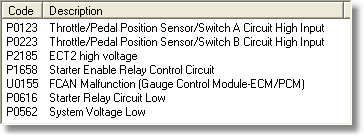
If you have any DTCs, then these should be fixed before proceeding with any vehicle tuning. For information on diagnosing and fixing DTCs, see you vehicle service manual. Normally there is a trouble shooting and fault diagnostic procedure for each DTC.
Readiness Codes
Readiness codes are part of the vehicle OBDII system, which indicate if the various components have been tested by the ECU.
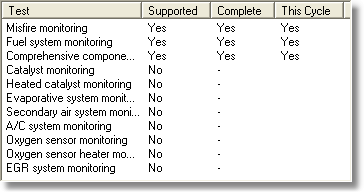
Readiness codes are either continuously monitored or monitored once per trip. Continuously monitored codes are checked by the ECU all the time. Current continuously monitored codes are:
| • | Misfire monitoring |
| • | Fuel system monitoring |
| • | Comprehensive component monitoring |
Non-continuously (or trip) monitored codes are checked by the ECU under specific conditions, which may be over several trips. See the vehicle service manual for information on how to set the vehicle readiness codes. Current non-continuous monitored codes are:
| • | Catalyst monitoring |
| • | Heated catalyst monitoring |
| • | Evaporative system monitoring |
| • | Secondary air system monitoring |
| • | A/C system refrigerant monitoring |
| • | Oxygen sensor monitoring |
| • | Oxygen sensor heater monitoring |
| • | EGR system monitoring |
Not all readiness codes are supported by all vehicles. If a test is marked as not supported then this does not mean there is a problem with that system.
If the ECU is re-programmed, DTCs are cleared, the ECU removed, or the battery is disconnected, then the readiness codes are all reset to 'incomplete'.
Setting Readiness Codes
When reset, readiness codes take several driving cycles to complete. Note that readiness codes will not set if there are any error codes. Continuously monitored readiness codes are usually marked as complete when other tests are not being run. A rough guide to setting the readiness codes is:
Catalyst - requires a working secondary oxygen sensor and good fuel tuning. Needs about 5 miles of stop/go driving with periods of steady cruise. If the catalyst is marginal it may take multiple driving cycles for this test to complete.
EVAP - requires a cold start, stop/go driving as warm-up and then 5-10 minutes of highway speed with steady throttle, without the engine being switched off.
Oxygen sensor - with a warm engine requires about 3.5 miles of driving including a 5 second period of deceleration with the throttle fully closed.
Oxygen sensor heater - typically takes 10-20 seconds after engine start to complete.
EGR - requires a warm engine about about 1 mile of driving.
A cold start is defined as the ECT being below 120 degrees, the IAT and ECT being within 7 degrees of each other and a minimum engine shut off time of 6 hours.
Parameters
This displays OBDII datalogging parameters.
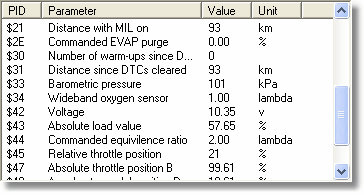
Information
This shows other information obtained via the OBDII interface.
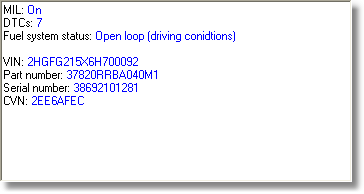
Emissions Check
This simulates the emissions test used by most emission testing stations.

If readiness codes are marked as incomplete then see your vehicle service manual for information on how to perform the readiness monitor driving cycles to complete testing.
Automatic Refresh
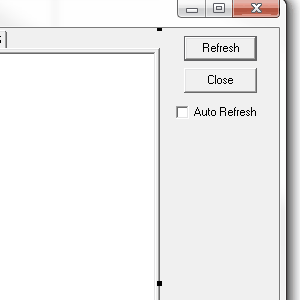
When checked, auto refresh continuously refreshes the information displayed in the OBDII window.
This shows DTCs from all modules attached to the CAN bus. Note that for many older vehicles only the ECU is attached to the CAN bus; modules using K-Line will not be shown.
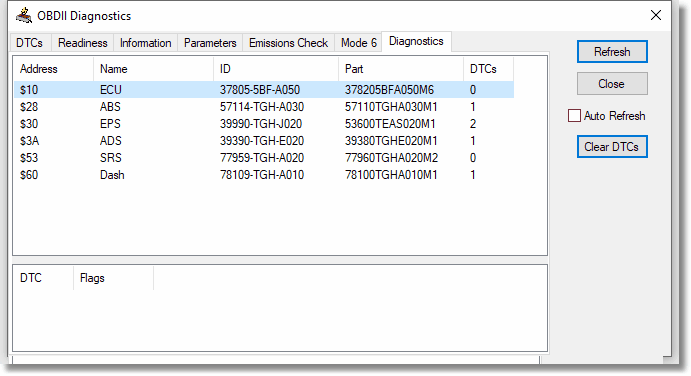
The Refresh button will first search for common modules on the CAN bus and show details. If the shift key is pressed when clicking on the Refresh button then a more exhaustive search for modules will be performed, which takes around a minute.
The Clear DTCs button will clear DTCs for all modules that have been found. This should be performed with the engine not running and after the DTC clear process has been completed, the ignition should be switched off for around a minute to allow modules to power down.